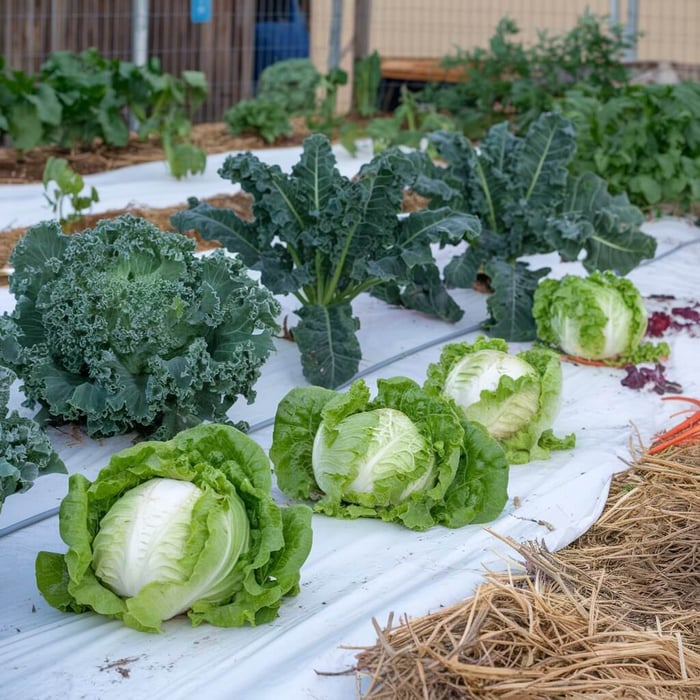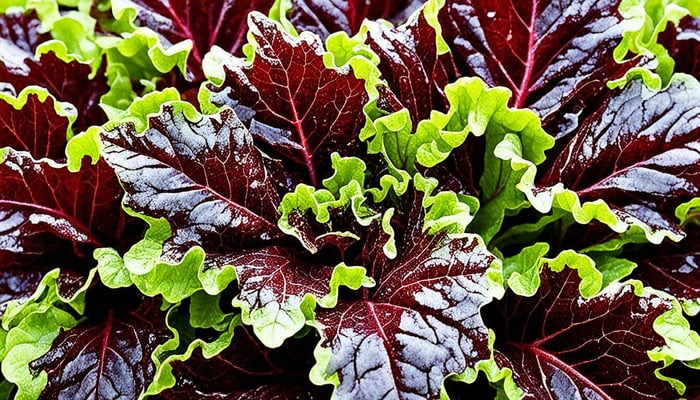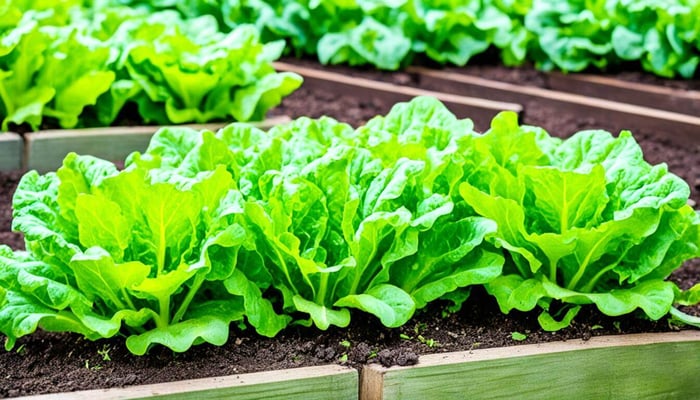Did you know some leafy greens can survive and even thrive in temperatures as low as 15°F? Among them is the remarkably resilient Tatsoi, a green that withstands the chill and brings a burst of mustard flavor to various dishes. As an ideal candidate for the fall harvest, it is no wonder that enthusiasts eager to grow green tatsoi from seed are reaping the benefits of this hardy and flavorful vegetable. Commonly referred to as spoon mustard, Tatsoi is a nutritional powerhouse and a beginner-friendly plant, making growing Tatsoi an excellent adventure for novice and experienced gardeners. Join us as we explore how to start seeding and nurturing your Tatsoi plants, paving the way for a lush, edible addition to your garden this fall. Let's learn how to grow green/mustard tatsoi from seed so you can enjoy it this year in your garden.
Key Takeaways
- Understanding the cold-hardiness of Tatsoi can influence planting schedules and extend growing seasons.
- Learning to start tatsoi from seed and manage young Tatsoi plants is essential for a successful yield.
- Recognizing Tatsoi's adaptability to partial shade can benefit gardeners with various light conditions.
- Discovering the savory mustard flavor of Tatsoi and how to incorporate it into meals adds culinary diversity.
- Anticipating the lush growth of Tatsoi ensures a fall harvest to be proud of.
Tatsoi Seeds
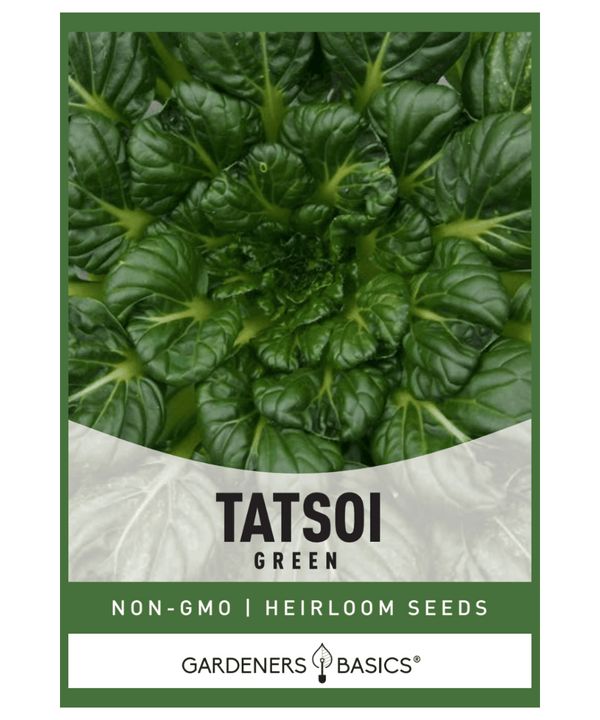
$2.49
Green Tatsoi Seeds - Heirloom, Non-GMO, Non-Hybrid, Open-Pollinated Discover the joy of growing your own fresh and flavorful Green Tatsoi with our premium heirloom seeds! A versatile and nutrient-packed Asian green, Green Tatsoi is a must-have for any gardener. This… read more
Tatsoi Seed Overview
- Days till maturity: Tatsoi typically matures in 45 to 50 days.
- Planting depth: Sow seeds at a depth of 1/4 inch (6 mm).
- Plant spacing: Space plants or thin them to 6 to 8 inches (15 to 20 cm) apart.
- Days to germination: Seeds usually germinate in 4 to 7 days.
- Indoors or Direct Sown: This can be started indoors or directly sown.
- Full Sun or Partial Shade: Performs well in full sun but prefers partial shade, especially in hot climates.
- When to harvest: Leaves can be harvested when 4 to 6 inches long, about 21 days for baby leaves and 45 to 50 days for full-sized leaves.
- How tall does the plant get? Tatsoi grows about 4 to 6 inches (10 to 15 cm).
- How wide does the plant get? The plant spreads 8 to 10 inches (20 to 25 cm) wide.
- Native: Tatsoi is native to East Asia.
- Family: It belongs to the Brassicaceae family, like mustards and cabbages.
Understanding Tatsoi: A Primer on the Asian Green
Embarking on a journey to cultivate Tatsoi Brassica rapa, a treasured variety within Asian greens, starts with a foundational knowledge of its characteristics and origins. Revered for its spoon-shaped foliage and subtle mustard flavor, tatsoi is a testament to culinary heritage and horticultural resilience. Now, let us delve deeper into what sets this leafy green apart and how it contrasts with its close relative, bok choy.
The Origin and Characteristics of Tatsoi Brassica Rapa
Tatsoi, a term that echoes its Asian lineage, is a robust member of the brassica family, sharing kinship with the likes of mustard greens and bok choy. Hailing from the extensive reaches of Asia, this plant has stood the test of time, flourishing in extensive culinary applications for centuries. Its distinct dark green leaves arrange themselves in a captivating rosette pattern, each leaf resembling a spoon poised gracefully at the end of its stem. This unique shape is more than mere aesthetics; it's a feature that enables the leaves to catch and hold droplets of water, a beautiful adaptation of nature.
Comparing Tatsoi to Bok Choy and Other Asian Greens
While tatsoi may share the spotlight with bok choy and other Asian greens, it stands out for its exceptional cold resistance. This characteristic allows tatsoi to extend its generosity well beyond the typical growing seasons, fitting effortlessly into fall and spring gardens. The taste of tatsoi is often likened to a mild mustard, imbuing dishes with a piquant yet unassuming flavor profile that complements rather than overwhelms. This balance of zest and mildness makes tatsoi highly versatile in many culinary ventures, from the raw crispness of salads to the gentle, cooked embrace of soups and stews.
Pre-Planting Tips: Preparing to Grow Tatsoi
As we embark on the journey to grow green tatsoi from seed, laying the groundwork for a thriving garden is crucial. With some know-how and preparation, you can create an ideal environment to nurture your tatsoi, from seedlings to full leafy greens. Let's talk about how to select the best site and soil conditions to get your plants off to a strong start.

Choosing the Right Site: Full Sun or Partial Shade Benefits
Location is paramount when planning where to plant your tatsoi. This versatile green can prosper in full sun conditions, but a growing site that offers partial shade, especially in the afternoon, is ideal in regions with hot summers. A partially shaded spot helps prevent your tatsoi from bolting, so your greens will be tender and tastier for longer.
Soil Requirements for Tatsoi: Draining Soil Essentials
The soil plays an essential role in your tatsoi's health. For best results, your garden's soil should have excellent draining soil properties, be rich in organic matter, and have a pH level between 6.0 and 7.5. Here's a comparative analysis of the impact different soil types can have on tatsoi growth:
| Soil Type | Drainage | pH Preference | Tatsoi Growth Impact |
|---|---|---|---|
| Sandy Loam | High | Moderately Acidic to Neutral | Optimal growth and root health |
| Clay | Slow | Neutral to Alkaline | Potential waterlogging and stunted growth |
| Rich Organic | Moderate | Slightly Acidic to Neutral | Enhanced flavor and leafy development |
Before sowing, clear your chosen site of weeds and debris to provide the most welcoming environment for your seeds. With these pre-planting practices in place, our green tatsoi will be poised to thrive, setting us up for a robust and flavorful harvest.
How To Grow Green/Mustard Tatsoi From Seed
For those looking to add a touch of spicy mustard flavor to their gardens and meals, growing green Tatsoi from seed is a journey worth embarking on. This versatile and flavorful Asian green is as rewarding to cultivate as it is to consume. Whether you're an urban gardener or have sprawling acres, we’ll guide you through sowing Tatsoi seeds for a successful harvest. Ready to start seeds like a pro? Let’s delve into the specifics.
Sowing Tatsoi Seeds: Start Seed Indoors or Direct Sown
We often encounter a key question: whether to start seed indoors or go straight to the garden bed. The answer? Either method can yield lush Tatsoi plants ripe with that distinctive mustard flavor. Should you choose to plant Tatsoi seeds indoors, aim for 2-3 weeks before the last expected frost. This gives your seedlings the jump-start they need. Direct sowing is equally effective, particularly if you're in an area with mild springs or looking for a fall harvest.
Optimizing Plant Spacing and Planting Depth for Healthy Growth
The understated art of planting depth and spacing can make all the difference in cultivating Tatsoi. Sow your seeds at a planting depth of 1/4 inch in well-aerated, nutrient-rich soil. Regarding plant spacing, 6 to 8 inches apart is the sweet spot. It allows each plant ample room to fan out its rosette of leaves, leading to better air circulation and overall plant health. Keep a close eye on the days to germination, which typically span between 4 to 7 days, though slight variances may occur with soil temperature fluctuations.
| Variety | Days to Germination | Planting Depth | Plant Spacing | Days till Maturity |
|---|---|---|---|---|
| Green Tatsoi | 4-7 | 1/4 inch | 6-8 inches | 40-50 |
| Mustard Tatsoi | 4-7 | 1/4 inch | 6-8 inches | 40-50 |
Remember, patience is key. In around 40-50 days till maturity, you’ll witness your Tatsoi reach a harvestable size—around 12 inches in width and height. The journey from seed to salad bowl is galvanizing, filled with the anticipation of crunchy leaves bursting with mustard flavor. With good planning and care, your Tatsoi plants will thrive. And when they do, you'll be rewarded with a green that's as ornamental as it is palatable, no matter the season.
Maintaining Your Tatsoi Plants for Optimal Growth
As dedicated gardeners, we understand the importance of maintaining tatsoi plants properly to ensure they reach their full potential. A lush, healthy crop of tatsoi provides a visually appealing garden and offers the delightful promise of a fresh, flavorful harvest. With proper care focused on watering, weeding, fertilizing, and thinning, your tatsoi plants will gift you with leaves with signature mustard flavor.
Watering and Weeding Practices for Tatsoi
One of the fundamentals of growing tatsoi is providing consistent moisture without overdoing it. Tatsoi flourishes in moist but well-draining soil, requiring an attentive watering schedule that keeps the soil hydrated but not waterlogged. Neglecting this balance can lead to poor root development or disease. Vigilant weeding also plays a key role, as weeds can quickly outcompete young tatsoi plants for essential nutrients and light. Establishing a weed management routine will preserve the resources needed for your tatsoi to grow inches tall and robust.

Fertilizing and Thinning Your Tatsoi for the Best Mustard Flavor
As tatsoi grows, they may require some intervention to maintain ideal growth conditions. Thinning the plants to a recommended distance of 6 to 8 inches apart ensures adequate air circulation and minimizes disease risk. This practice promotes stronger plants and contributes to their full mustard flavor. Additionally, a mid-season application of balanced, organic fertilizer can invigorate your tatsoi, encouraging a vibrant, leafy output ready for harvesting tatsoi when the time comes. With these maintenance strategies, expect a bounty of healthy and flavorful tatsoi leaves ready for your culinary creations.
Proper maintenance is the cornerstone of a thriving tatsoi plot. By adhering to these essential practices, we can eagerly anticipate a lush and productive garden, promising a delightful harvesting tatsoi experience. Every gardener's effort poured into caring for these greens will surely be reflected in the quality and flavor of every leaf cultivated—a true testament to the art of gardening.
Hydroponic Seeds For Planting | 5 High-Quality Varieties
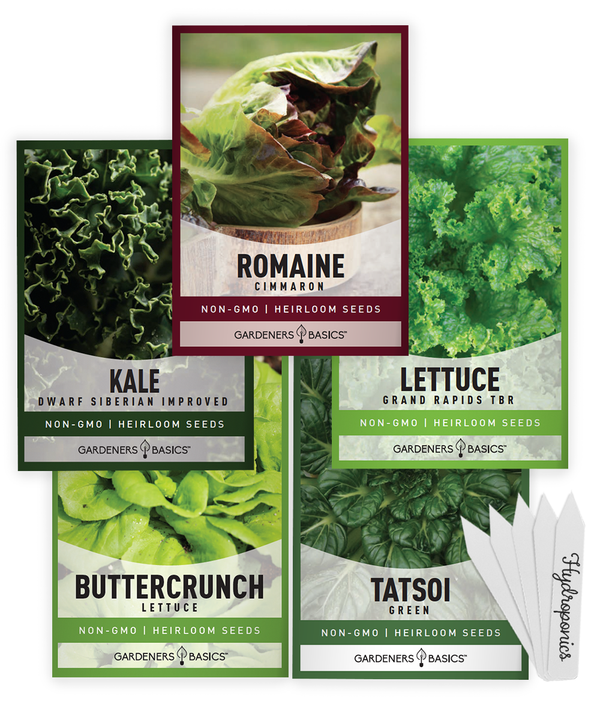
$9.95
Best Hydroponic Seeds Variety Pack for Indoor Gardening Success Introducing our 5 Hydroponics Seeds Variety Pack, a carefully curated selection of premium heirloom seeds, perfect for any indoor or hydroponic gardening enthusiast. This variety pack offers the ideal mix of… read more
Harvesting and Using Your Tatsoi
As the crisp air signals the approach of the fall harvest, our tatsoi plants beckon for attention, promising a bounty of lush greens ripe with mustard flavor. There is an art to harvesting tatsoi, timing being of the essence to capture its peak condition. Experience the satisfaction of gathering the fruits of your labor and relish in the multitude of ways tatsoi brings vitality to your table.
Knowing When to Harvest: Identifying the Signs for the Fall Harvest
Discerning when to harvest tatsoi is key to enjoying its optimal flavor and texture. Look for vibrant, deep green leaves that have reached a length of about 5 to 6 inches for a tender and robust taste. Some gardeners may opt for even smaller leaves, preferring their softer texture. The choice is yours, but take note: tatsoi is at its prime when it measures approximately 12 inches across. You can cut the outer leaves individually, permitting the plant to continue growing, or harvest the entire rosette once it spans its total diameter.
Incorporating Tatsoi in Meals: Stir Fries and Beyond
After successfully harvesting tatsoi, the culinary adventure begins. This Asian green plays a starring role in stir-fries, where its leaves wilt perfectly amongst a medley of flavors. Yet Tatsoi's versatility extends far beyond the wok. Relish its crisp freshness in salads, steam for a simple, healthful side, or incorporate the leaves into soups and sandwiches for an extra layer of texture and mustard flavor. No matter the dish, tatsoi delivers a nutritional punch, transforming the simplest meal into a flavorsome experience.
| Method | Description | Benefits |
|---|---|---|
| Raw in Salads | Tatsoi leaves are sliced or torn for salads. | Preserves the crisp texture and fresh mustard flavor. |
| Stir-Fried | Cooked quickly with high heat in a wok or pan. | Leaves become tender; flavors concentrate. |
| Steamed | Gently steamed to a perfect wilt. | Maintains nutritional value while softening leaves. |
| Added to Soups | Incorporated into soups for the last few minutes of cooking. | Gives soups a subtle spice and enriching green color. |
As the season wanes and you gather your tatsoi, embrace the full circle of growth—from seed to harvest—and the joy of enjoying greens from your garden. It's time to savor the 12 inches of pure, homegrown delight and share the vibrant mustard flavor of tatsoi in every meal.
Conclusion - How to Grow Green/Mustard Tatsoi From Seed
We've navigated the rewarding journey of growing tatsoi, from the initial scattering of seeds to the joyous moments of the fall harvest. The process is of patience and care, yet each step brings delight. There's something deeply gratifying about nurturing spoon mustard, witnessing the vibrant green leaves unfurl, and ultimately enjoying our table's fresh, organic bounty. In our shared mission to cultivate health, tatsoi is a beacon—a leafy herald of the value of growing our Asian greens.
Benefits of Growing Tatsoi: From Seed to Table
As gardeners, we know the multifaceted benefits of tending to tatsoi. From the practicality and satisfaction of raising beds of the lush Asian green to the nutritional richness it bestows upon our meals, every aspect of growing tatsoi enriches our lives. Each leaf harvested represents our commitment to sustainable living and the empowerment of self-sufficiency. Tatsoi invigorates not just our garden space but also our health with its dense content of vitamins and minerals. We're reminded of the simple, profound bond between earth and eater as we partake in this bounty.
Expansion of Your Gardening with Spoon Mustard
Whether you're a seasoned green thumb or just stepping into the gardening world, embracing tatsoi can broaden your horticultural horizons. This resilient relative of the mustard family is well-suited for diverse arrangements, thriving in the coziest container gardens, hydroponic gardens, and the expansiveness of raised beds. Its adaptability and swift maturity make it a perfect candidate for those aiming to extend their gardening repertoire and enjoy a hearty fall harvest. Engaging with tatsoi isn't merely about adding to our culinary options—it's an opportunity to deepen our connection with the rhythm of nature and the food we eat. Here's to integrating the noble spoon mustard into our gardens and our plates for future seasons.
FAQ - Growing Tatsoi From Seed
What is tatsoi and its origin?
Tatsoi, scientifically known as Tatsoi Brassica Rapa, is an Asian green belonging to the brassica family. It is native to Asia and has dark green, spoon-shaped leaves with a subtle mustard-like flavor.
How does tatsoi compare to bok choy?
While tatsoi and bok choy are Asian greens and share similarities in nutritional value and culinary uses, tatsoi is noted for its cold tolerance, faster growth, and distinctive spoon-shaped leaves, setting it apart from bok choy and other similar vegetables.
What are the best conditions for growing tatsoi from seed?
Tatsoi thrives in various environments and can be grown in full sun to partial shade. It prefers rich, well-draining soil with a pH of 6.0 to 7.5. Consistent moisture and good soil fertility are also important for optimal growth.
When should I plant tatsoi, and how deep should the seeds be?
Tatsoi seeds can be started indoors or directly sown in the garden. The seeds should be planted 1/4 inch deep and spaced 6 to 8 inches apart to allow adequate room for growth.
What is the proper way to water and fertilize tatsoi?
Water tatsoi plants consistently to maintain moist but well-draining soil. Avoid over-watering to prevent root issues. Mid-season, apply a balanced, organic fertilizer to encourage vibrant growth and enhance the mustard flavor of the leaves.
How do I know when it's time to harvest tatsoi, and what is the best way to use it?
Harvest tatsoi when the leaves are about 5 to 6 inches long for a tender flavor, or wait until the plant reaches approximately 12 inches in diameter for a larger harvest. Tatsoi is versatile and can be used in stir-fries, salads, and soups, adding a nutritious and flavorful element to meals.
Can I grow tatsoi in raised beds or containers?
Yes, tatsoi can be successfully grown in raised beds or containers. This flexibility makes it an excellent choice for gardeners with limited space or those looking to extend their growing season into cooler months.
Vegetable Seed Vault Kit | 35 Variety Pack

$29.95
$49.95
Ultimate Survival Seed Vault: 16,000+ Non-GMO Heirloom Vegetable Seeds for Emergency Preparedness Introducing the Seed Vault Kit, your all-in-one solution for emergency preparedness and sustainable gardening. This premium seed kit contains over 16,000 non-GMO, Heirloom, Non-Hybrid, and Open Pollinated seeds,… read more





